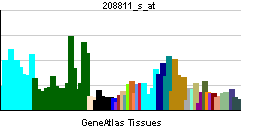DNAJB6
| DnaJ (Hsp40) homolog, subfamily B, member 6 | |||||||||||
|---|---|---|---|---|---|---|---|---|---|---|---|
| Identifiers | |||||||||||
| Symbols | DNAJB6 ; HSJ2; DKFZp566D0824; FLJ42837; HHDJ1; HSJ-2; MGC1152; MGC117297; MRJ; MSJ-1 | ||||||||||
| External IDs | Template:MGI HomoloGene: 38058 | ||||||||||
| |||||||||||
| RNA expression pattern | |||||||||||
 | |||||||||||
 | |||||||||||
| More reference expression data | |||||||||||
| Orthologs | |||||||||||
| Template:GNF Ortholog box | |||||||||||
| Species | Human | Mouse | |||||||||
| Entrez | n/a | n/a | |||||||||
| Ensembl | n/a | n/a | |||||||||
| UniProt | n/a | n/a | |||||||||
| RefSeq (mRNA) | n/a | n/a | |||||||||
| RefSeq (protein) | n/a | n/a | |||||||||
| Location (UCSC) | n/a | n/a | |||||||||
| PubMed search | n/a | n/a | |||||||||
DnaJ (Hsp40) homolog, subfamily B, member 6, also known as DNAJB6, is a human gene.[1]
This gene encodes a member of the DNAJ protein family. DNAJ family members are characterized by a highly conserved amino acid stretch called the 'J-domain' and function as one of the two major classes of molecular chaperones involved in a wide range of cellular events, such as protein folding and oligomeric protein complex assembly. This family member may also play a role in polyglutamine aggregation in specific neurons. Alternative splicing of this gene results in multiple transcript variants; however, not all variants have been fully described.[1]
References
Further reading
- Maruyama K, Sugano S (1994). "Oligo-capping: a simple method to replace the cap structure of eukaryotic mRNAs with oligoribonucleotides". Gene. 138 (1–2): 171–4. PMID 8125298.
- Suzuki Y, Yoshitomo-Nakagawa K, Maruyama K; et al. (1997). "Construction and characterization of a full length-enriched and a 5'-end-enriched cDNA library". Gene. 200 (1–2): 149–56. PMID 9373149.
- Seki N, Hattori A, Hayashi A; et al. (1999). "Cloning, tissue expression, and chromosomal assignment of human MRJ gene for a member of the DNAJ protein family". J. Hum. Genet. 44 (3): 185–9. PMID 10319584.
- Izawa I, Nishizawa M, Ohtakara K; et al. (2000). "Identification of Mrj, a DnaJ/Hsp40 family protein, as a keratin 8/18 filament regulatory protein". J. Biol. Chem. 275 (44): 34521–7. doi:10.1074/jbc.M003492200. PMID 10954706.
- Hartley JL, Temple GF, Brasch MA (2001). "DNA cloning using in vitro site-specific recombination". Genome Res. 10 (11): 1788–95. PMID 11076863.
- Ohtsuka K, Hata M (2001). "Mammalian HSP40/DNAJ homologs: cloning of novel cDNAs and a proposal for their classification and nomenclature". Cell Stress Chaperones. 5 (2): 98–112. PMID 11147971.
- Wiemann S, Weil B, Wellenreuther R; et al. (2001). "Toward a catalog of human genes and proteins: sequencing and analysis of 500 novel complete protein coding human cDNAs". Genome Res. 11 (3): 422–35. doi:10.1101/gr.154701. PMID 11230166.
- Chuang JZ, Zhou H, Zhu M; et al. (2002). "Characterization of a brain-enriched chaperone, MRJ, that inhibits Huntingtin aggregation and toxicity independently". J. Biol. Chem. 277 (22): 19831–8. doi:10.1074/jbc.M109613200. PMID 11896048.
- Farinha CM, Nogueira P, Mendes F; et al. (2002). "The human DnaJ homologue (Hdj)-1/heat-shock protein (Hsp) 40 co-chaperone is required for the in vivo stabilization of the cystic fibrosis transmembrane conductance regulator by Hsp70". Biochem. J. 366 (Pt 3): 797–806. doi:10.1042/BJ20011717. PMID 12069690.
- Strausberg RL, Feingold EA, Grouse LH; et al. (2003). "Generation and initial analysis of more than 15,000 full-length human and mouse cDNA sequences". Proc. Natl. Acad. Sci. U.S.A. 99 (26): 16899–903. doi:10.1073/pnas.242603899. PMID 12477932.
- Scherer SW, Cheung J, MacDonald JR; et al. (2003). "Human chromosome 7: DNA sequence and biology". Science. 300 (5620): 767–72. doi:10.1126/science.1083423. PMID 12690205.
- Hillier LW, Fulton RS, Fulton LA; et al. (2003). "The DNA sequence of human chromosome 7". Nature. 424 (6945): 157–64. doi:10.1038/nature01782. PMID 12853948.
- Hanai R, Mashima K (2004). "Characterization of two isoforms of a human DnaJ homologue, HSJ2". Mol. Biol. Rep. 30 (3): 149–53. PMID 12974469.
- Ota T, Suzuki Y, Nishikawa T; et al. (2004). "Complete sequencing and characterization of 21,243 full-length human cDNAs". Nat. Genet. 36 (1): 40–5. doi:10.1038/ng1285. PMID 14702039.
- Liu Y, Zhu MC, Wang YJ; et al. (2004). "[Cloning of a DnaJ homolog chaperon PBP and its subcellular localization]". Xi Bao Yu Fen Zi Mian Yi Xue Za Zhi. 19 (6): 531–4. PMID 15182641.
- Berruti G, Martegani E (2005). "The deubiquitinating enzyme mUBPy interacts with the sperm-specific molecular chaperone MSJ-1: the relation with the proteasome, acrosome, and centrosome in mouse male germ cells". Biol. Reprod. 72 (1): 14–21. doi:10.1095/biolreprod.104.030866. PMID 15342353.
- Gerhard DS, Wagner L, Feingold EA; et al. (2004). "The status, quality, and expansion of the NIH full-length cDNA project: the Mammalian Gene Collection (MGC)". Genome Res. 14 (10B): 2121–7. doi:10.1101/gr.2596504. PMID 15489334.
- Wiemann S, Arlt D, Huber W; et al. (2004). "From ORFeome to biology: a functional genomics pipeline". Genome Res. 14 (10B): 2136–44. doi:10.1101/gr.2576704. PMID 15489336.
- Rual JF, Venkatesan K, Hao T; et al. (2005). "Towards a proteome-scale map of the human protein-protein interaction network". Nature. 437 (7062): 1173–8. doi:10.1038/nature04209. PMID 16189514.
- Dai YS, Xu J, Molkentin JD (2005). "The DnaJ-related factor Mrj interacts with nuclear factor of activated T cells c3 and mediates transcriptional repression through class II histone deacetylase recruitment". Mol. Cell. Biol. 25 (22): 9936–48. doi:10.1128/MCB.25.22.9936-9948.2005. PMID 16260608.
| This protein-related article is a stub. You can help Wikipedia by expanding it. |